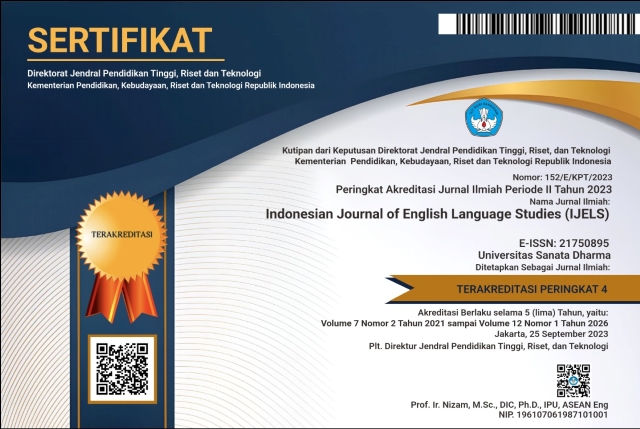The Representation of Skepticism in Don’t Look Up Film: An Overview of Current Environmental Issue
(1) Universitas Islam Makassar, Indonesia
(2) Universitas Islam Makassar, Indonesia
(3) Universitas Islam Makassar, Indonesia
(*) Corresponding Author
Abstract
Keywords
Full Text:
PDFReferences
Baghramian, M., & Caprioglio Panizza, S. (2022). Scepticism and the value of distrust. Inquiry: An Interdisciplinary Journal of Philosophy, 31(3), 402–423. https://doi.org/10.1080/0020174X.2022.2135821
Botwinick, A. (2010). Skepticism. Temple University Press.
Cloete, A. L. (2017). Film as medium for meaning making: A practical theological reflection. HTS: Theological Studies, 73(4), 1–6. https://doi.org/10.4102/hts.v73i4.4753
Danesi, M. (2004). Messages, signs, and meanings: A basic textbook in semiotics and communication (Vol. 1). Canadian Scholars’ Press.
Doherty, T. J., & Clayton, S. (2011). The psychological impacts of global climate change. American Psychologist, 66(4), 265. https://doi.org/10.1037/a0023141
Erkkilä, J. (2004). From signs to symbols, from symbols to words. Voices: A World Forum for Music Therapy, 4(2). https://doi.org/10.15845/voices.v4i2.176
Hoffmann, R., Muttarak, R., Peisker, J., & Stanig, P. (2022). Climate change experiences raise environmental concerns and promote green voting. Nature Climate Change, 12(2), 148–155. https://doi.org/10.1038/s41558-021-01263-8
Huang, J., & Darmayanti, D. (2014). Factors affecting skepticism toward green advertising: A study of university students in Jakarta. Journal of Business Strategy and Execution, 7(1), 23–44. https://journal.binus.ac.id/index.php/JBSE/article/view/808
Klein, P. D. (2005). Skepticism.
Macarthur, D. (2016). Living our skepticism of others through film: Remarks in Light of Cavell. SubStance, 45(3), 120–136. https://doi.org/10.1353/sub.2016.0032
Milfont, T. L. (2010). Global warming, climate change and human psychology. In V. Corral-Verdugo, C. H. Garcia-Cadena, & M. Frias-Arment (Eds.). Psychological approaches to sustainability: Current trends in theory, research and practice. New York: Nova Science Publisher
Moore, K. C. (2014). Signals, symbols, and representational activity. In L. P. Steffe, K. C. Moore, L. L. Hatfield, & S. Belbase (Eds.), Epistemic algebraic students: Emerging models of students' algebraic knowing (pp. 211-235). Laramie, WY: University of Wyoming.
Moritz, J. M. (2009). Doubt, deception, and dogma: Science and religion in film. Theology and Science, 7(3), 207–212. https://doi.org/10.1080/14746700903035066
Mravcová, A. (2019). Environmental awareness and environmental citizenship dimension. Slovenská Politologická Revue, 19(2), 32–48. https://doi.org/10.34135/sjps.190202
Nasution, M. Z. A., Safirra, H. A. M., & Farid, A. S. (2023). Public perception of environmental and sustainability issues in North Sumatra: A mass media perspective. Jurnal Ilmu Sosial Mamangan, 12(2), 327–342. https://www.researchgate.net/publication/376383701_
Public_Perception_of_Environmental_and_Sustainability_Issues_in_North_Sumatra_A_Mass_Media_Perspective
Ottuh, P. O. O. (2022). An evaluation of religious skepticism in relation to human suffering and pain: towards a theodical synthesis. ICOANA CREDINTEI, 8(16), 50–61.
Peirce, C. S. (1991). Peirce on signs: Writings on semiotic. UNC Press Books.
Sarah, R. (2021). Representation of feminism in the film of Jane Eyre (2011): Semiotics analysis study of Charles Sanders Peirce. Titian: Jurnal Ilmu Humaniora, 5(2), 196–210. https://doi.org/10.22437/titian.v5i2.15283
Schmerheim, P. (2015). Skepticism films: Knowing and doubting the world in contemporary cinema. Bloomsbury Publishing USA. https://doi.org/10.5040/9781501311000
Sinnott-Armstrong, W. (2006). Moral skepticism. Oxford University Press. https://doi.org/10.1093/0195187725.001.0001
Subardja, N. C., & Arviani, H. (2021). Representasi postfeminime dalam film; Intelektualitas, kepemimpinan dan kedudukan Princess “Mulan.” Representamen, 7(02). https://doi.org/10.30996/representamen.v7i02.5725
Trifonova, T. (2011). Film and skepticism: Stanley Cavell on the ontology of film. Rivista Di Estetica, 46, 197–219. https://doi.org/10.4000/estetica.1653
Wahab, Z., Tama, R. A., Shihab, M. S., Widad, A., Nofiawaty, N., & Diah, Y. M. (2017). Analysis the effect of environmental concern and green advertising to green purchasing in Palembang City. Sriwijaya International Journal of Dynamic Economics and Business, 1(3), 297–310. https://doi.org/10.29259/sijdeb.v1i3.297-310
Weber, E. U. (2010). What shapes perceptions of climate change?. Wiley Interdisciplinary Reviews: Climate Change, 1(3), 332–342. https://doi.org/10.1002/wcc.41
Williams, M. (2017). Skepticism. The Blackwell Guide to Epistemology, 33–69. https://doi.org/10.1002/9781405164863.ch1
Wollen, P. (2019). Signs and meaning in the cinema. Bloomsbury Publishing.
DOI: https://doi.org/10.24071/ijels.v10i2.8616
Refbacks
- There are currently no refbacks.

This work is licensed under a Creative Commons Attribution-ShareAlike 4.0 International License.
IJELS Journal Sinta 4 Certificate (S4 = Level 4)
We would like to inform you that Indonesian Journal of English Language Studies (IJELS) has been nationally accredited Sinta 4 by the Ministry of Education, Culture, Research and Technology of the Republic of Indonesia based on the decree No. Surat Keputusan 152/E/KPT/2023. Validity for 5 years: Vol 7 No 2, 2021 till Vol 12 No 1, 2026

This work is licensed under CC BY-SA.
Creative Commons Attribution-ShareAlike 4.0 International License
IJELS e-ISSN 2715-0895; IJELS p-ISSN 2442-790X
Indonesian Journal of English Language Studies (IJELS) is published twice a year, namely in March and September, by the English Language Studies (ELS) of the Graduate Program of Sanata Dharma University, Yogyakarta, Indonesia.


 IJELS p-ISSN:
IJELS p-ISSN: 











